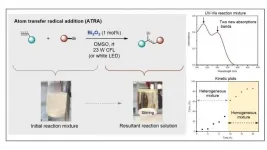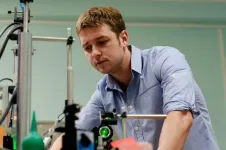Brightening the future of semiconductor-based photocatalytic processes
* The researchers have pinpointed that the true active photocatalytic species in a model ARTA reaction is a complex salt of bismuth hexabromide
2021-02-01
(Press-News.org) A collaboration between the Pericàs group with Prof. Timothy Noël and Dr. Paola Riente at the Eindhoven University of Technology (TU/e, The Netherlands), has crystallised in a Nature Communications paper where they provide key insight into the chemical nature of the true photocatalyst involved in the Bi2O3-driven atom-transfer radical addition (ATRA) reaction.
Back in 2014, ICREA professors Miquel Pericàs and Emilio Palomares together with former postdoctoral researcher Dr. Riente published a paper on Angewandte Chemie International Edition pioneering the research on organic transformations in mild reactions conditions by using Bi2O3 and visible light as a sustainable alternative to other transition metals. On the rise of new green approaches for efficient catalysis, Bi2O3 has become popular as a photocatalyst to drive light-induced organic transformations due to its low price, non-toxicity, solid nature, high availability and visible light response. Moreover, in some cases, it can replace the use of metal complexes based on expensive and non-abundant ruthenium and iridium transition metal photocatalysts.
The researchers set out to unravel the atom transfer radical addition (ATRA) reaction between diethyl bromomalonate (DEBM) and 5-hexen-1-ol as a reaction model. As the reaction progresses, the mixture evolves from a suspension to a yellowish transparent solution. This quickly caught the researcher's attention, as Bi2O3 isn't soluble in organic solvents. Therefore, "we envisaged that the interaction of Bi2O3 with some component of the reaction was forming, under irradiation, a homogeneous bismuth-based intermediate species that worked as the true photocatalyst of the reaction," explains Dr. Riente, first author of the paper.
Reaching out to Dr. Mauro Fianchini, a theoretical postdoc working in the Pericàs group, the team devised a theoretical model that has helped elucidate that the catalytically active species involved in photocatalytic processes where Bi2O3 is used are actually closely related to pure BiBr3 or BiBr3- based complexes. In the presence of dimethyl sulfoxide (DMSO) or dimethylformamide (DMF), Bi2O3 transforms into BiBr3- based complexes, photocatalytic species able to absorb light, ultimately triggering the formation of the required alkyl radical in ATRA and alkylation reactions.
Pushing this idea forward, the researchers performed calculations of few solvate complexes where DMSO was coordinating with BiBr3 to find the ideal candidate. Combining these computational insights with the structural information provided by X-ray diffraction the team has cracked the puzzle, finding that the active photocatalytic species is a complex salt of bismuth hexabromide. In fact, a mixture composed of [(BiBr6)]3? octahedral anions balanced by [(CH3)3S]+ cations and [(CH3)3S]Br.
Using the words of Dr. Fianchini "this is a good foundation. This research is the basement of the "house" and, looking forward, we will start growing up the walls and put a roof on by proposing the mechanisms behind the solvation of the precatalyst and the ATRA activation of organic substrates of interest."
INFORMATION:
[Attachments] See images for this press release:

ELSE PRESS RELEASES FROM THIS DATE:
2021-02-01
The work of the research group under the guidance of Professor Leonid Martyushev (co-authors: Roman Bando and Evgenia Chervontseva) will help to predict the behavior of fluids in various environments.
"When oil wells are depleted, water is pumped there under pressure to force the residual oil to the surface. If the interface between water and oil were an even layer, then it would be safe to say that as a result of water injection we recover all the residual oil. But since the interface between the two liquids is a highly distorted section, oil, contrary to expectations, can still remain underground, while water comes out to the surface. This is where our calculations come in ...
2021-02-01
The coronavirus crisis has led to some of the general public developing a critical view of the current food consumption model, as shown by a recent survey by the Catalan Consumer Agency, which reveals that 60.5% of all Catalans tend to think that the pandemic will promote more responsible, sustainable and fair consumption. Moreover, the various lockdowns have caused a significant increase in online shopping throughout Spain, with a 92% rise in volume and a 114.5% rise in value, according to aggregated consumption data from the Ministry of Agriculture, Fisheries and Food. This change in shopping habits and the awareness of the food model may also ...
2021-02-01
The human body strives to keep itself in homeostasis, or balance. When blood clots are created, the body's innate response is to break the clots down to prevent significant health problems from arising.
Research has found that patients with COVID-19 are prone to serious blood clotting. This is why many patients receive high dose anticoagulants as part of their treatment.
But a new study in Scientific Reports, led by senior author Daniel Lawrence, Ph.D., a Professor of Basic Research in Cardiovascular Medicine at Michigan Medicine, found that aside ...
2021-02-01
New research by Swansea University scientists found that boat ramps facilitate the dispersal of the highly invasive zebra mussel (Dreissena polymorpha).
To contain the dispersion of this invasive species Dr Marta Rodriguez-Rey and co-authors suggest in the new study, that strict control measures and target monitoring around boat ramps should be implemented.
Invasive bivalves are a problem as they can cause widespread environmental damage, and eradication has proved difficult. The zebra mussel is one of the most damaging invasive bivalves - it reproduces fast, disperses widely, and damages the economy. In Great Britain, £5 million are lost each year due to pipe fouling and damage to water infrastructures caused ...
2021-02-01
Titanium dioxide nanoparticles decorated by gold absorb about 96% of the solar spectrum and turn it into heat. The material can accelerate the evaporation in desalination plants up to 2.5 times and can track hazardous molecules and compounds. An international research team with representatives from Far Eastern Federal University (FEFU), ITMO University, and the Far Eastern Branch of the Russian Academy of Sciences, published a related article in ACS Applied Materials and Interfaces.
Access to safe water is included in the 17 UN Sustainable Development Goals. Meanwhile, the World Health Organization (WHO), and the Children's Fund (UNICEF) addressed the problem in 2019 report, noting that 2.2 ...
2021-02-01
In Rome lies the Santi Apostoli church, cared for by Franciscan brothers for more than 500 years. For more than 1500 years, this site has held the believed remains of two of the earliest Christians and Jesu apostles: St. Philip and St. James the Younger - relics of the Holy Catholic Church.
In the first few centuries of Christianity, life was difficult for the Christian minority, but gradually towards sixth century Christianity became the dominant religion and after Emperor Constantine on his deathbed declared Christianity the state religion, churches were erected all over the Roman Empire.
Shortly after the churches were erected, remains of worshipped Christian martyrs were moved from their ...
2021-02-01
The application Radar COVID detects twice as many close contacts of people infected with the virus SARS-Cov2 as the manual tracing system. This is the conclusion of the first scientific study that was carried out to assess the application in a trial carried out last summer on the island of La Gomera in the Canary Islands. The following researchers were involved in the project; Àlex Arenas, professor from the Department of Computer Engineering and Mathematics; Lucas Lacasa, from the Queen Mary University, London; and Pablo Rodríguez, from the Association of Computing Machinery, United States. The results have been published in the scientific journal Nature Communications.
The aim of the study was to check the technical and ...
2021-02-01
An atlas of harmful algal blooms across the Red Sea reveals their link with industrial aquaculture and how these blooms have changed in recent decades.
Warming oceans and anthropogenic pollution have led to more frequent and extensive harmful algal blooms (HABs) worldwide. These rapid surges in productivity occur when algae suddenly experience advantageous conditions, usually an influx of nutrients, and take over their environment, suffocating other marine life and spreading toxins through the food chain. These blooms harm wild and farmed fish and reduce marine biodiversity.
"HABs are a global problem," says ...
2021-02-01
Per capita income, population volume and density, the structure of cities, transport infrastructure or whether districts have their own schools are all factors that can affect the spread of COVID-19. This has been confirmed by a study carried out in 73 districts in Barcelona by researchers from the departments of Geography and Economics of the Universitat Rovira i Virgili, the results of which have been published in the Journal of Public Health. The research reveals that the analysis of the characteristics of every district can facilitate decisions on the specific measures to be applied to individual districts ...
2021-02-01
Flinders University researchers have discovered a new anti-inflammatory role for well-known blood clot protein fibrinogen, which could support targeted new treatments for kidney, heart and other common diseases.
The study in Redox Biology describes how fibrinogen can be protective against hypochlorite - a chemical generated by the body during inflammation - and so act as a kind of antioxidant in blood plasma.
"Our team found that fibrinogen, which forms extraordinarily large assemblies when it reacts with hypochlorite, doesn't harm cells in the same way as hypochlorite-modified albumin which exacerbates kidney and heart disease, ...
LAST 30 PRESS RELEASES:
[Press-News.org] Brightening the future of semiconductor-based photocatalytic processes
* The researchers have pinpointed that the true active photocatalytic species in a model ARTA reaction is a complex salt of bismuth hexabromide




